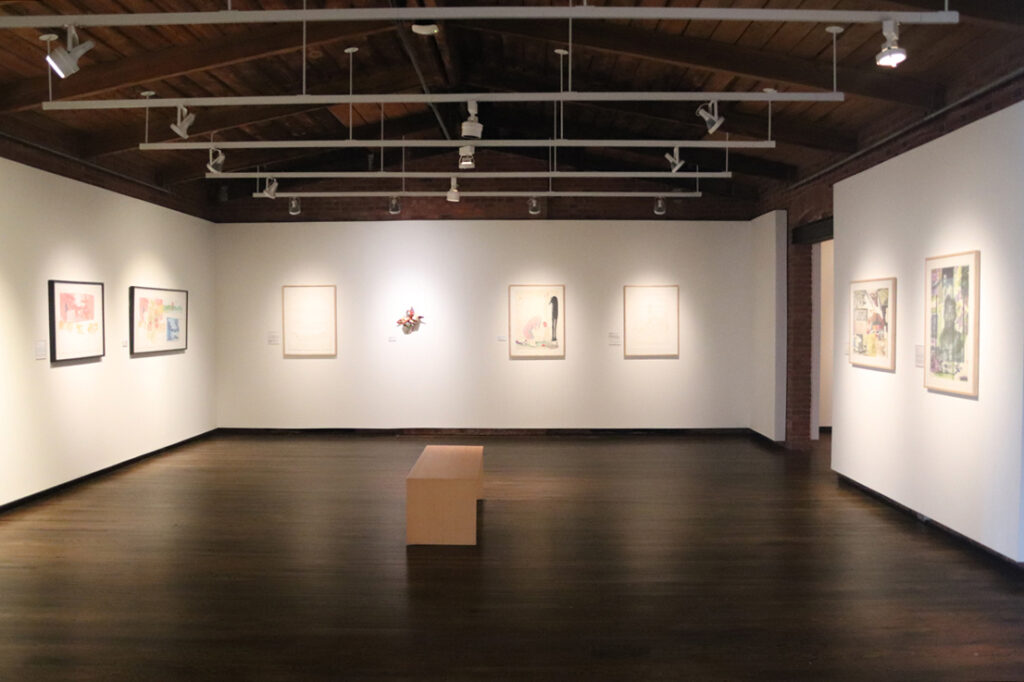
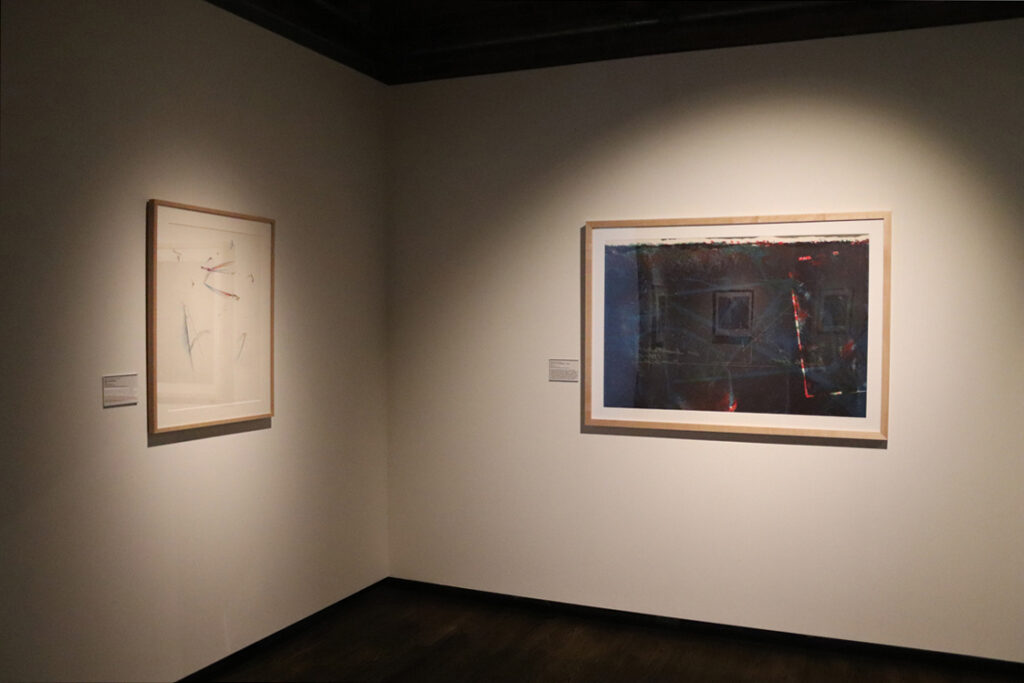

7.
John E. Dowell, Jr. (b. 1941)
2B+C/Tomorrow
1983
Offset lithograph
Museums Collections, Gift of Brandywine Workshop, Philadelphia, PA
Philadelphia-native John E. Dowell Jr. has been a professional photographer, painter, and printmaker for over four decades. Between 1970 and the early 1990s, a driving force in Dowell’s art was his endeavor to interpret jazz music visually. In a 2004 interview, he said, “I became aware that in jazz music, it was not just the notes but the intervals between them that become important.” 2B+C/Tomorrow evokes time and music through its sparse articulation of marks in various sizes and colors across the blank space of the paper.
8.
Sam Gilliam (b. 1933)
1981-82 An Installation – Large
1981
Silkscreen
Museums Collections, Gift of Brandywine Workshop, Philadelphia, PA
Although Sam Gilliam is best known for his “drape” paintings – unstretched canvases colored with vibrant pigments and then hung as three-dimensional, site-specific installations – his printmaking experiments have produced some of the most compelling works of his fifty-year career. In the 1980s, he collaborated with artists at the Brandywine Workshop to create works such as 1981-82 An Installation – Large and Untitled. The assemblage techniques and the layered manipulation of color and abstract forms in Untitled prefigures the work that Gilliam would pursue during his tenure at the EPI.
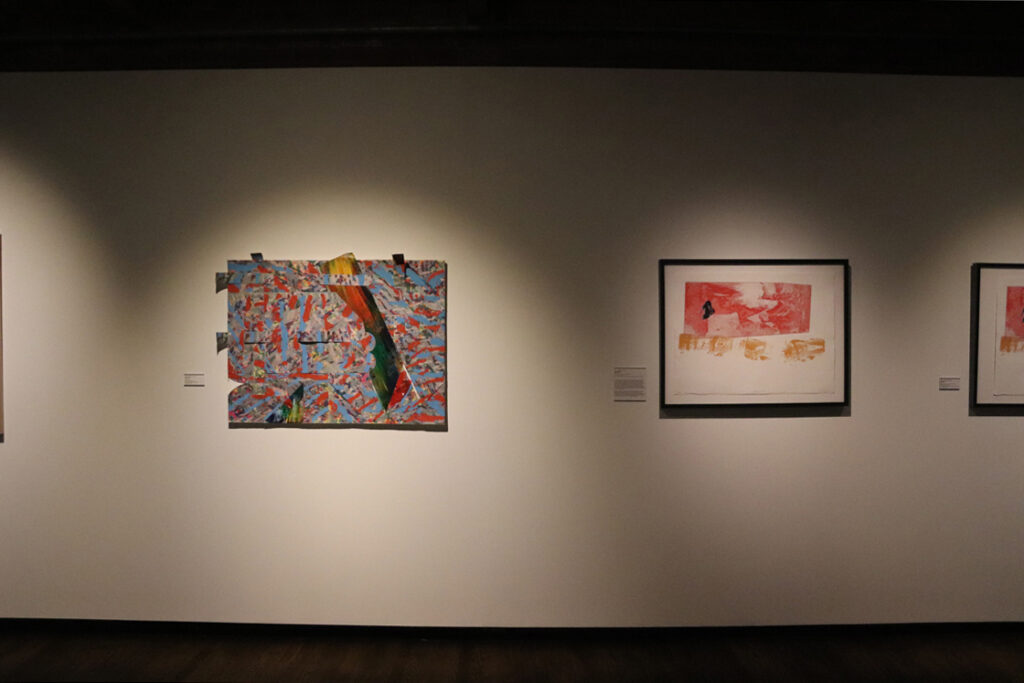
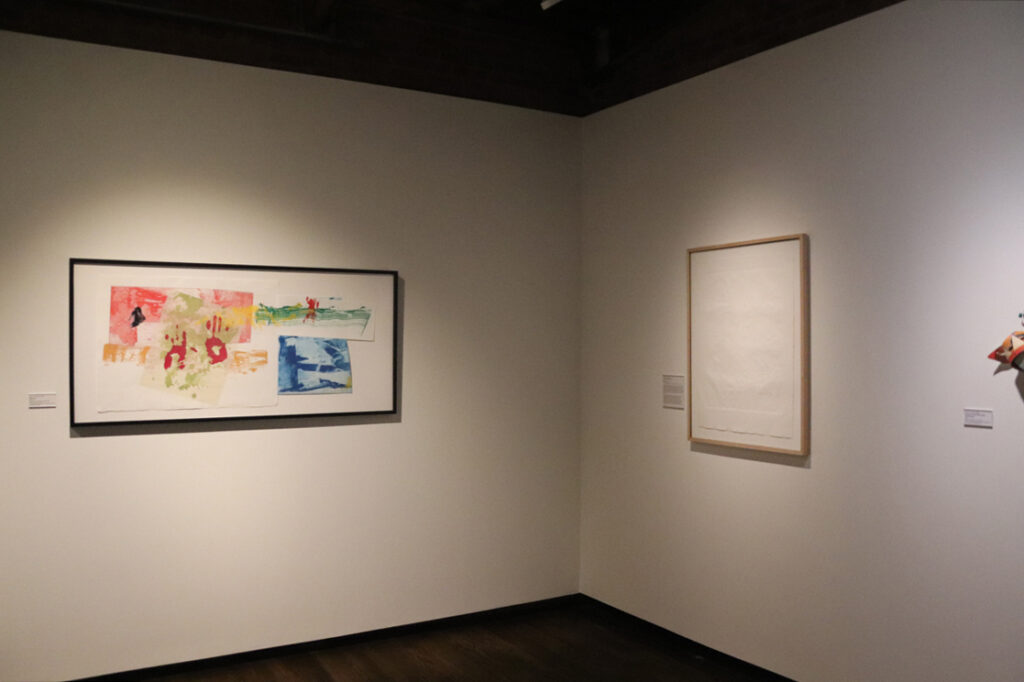
9.
Sam Gilliam (b. 1933)
Untitled
1987
Assemblage
Museums Collections, Gift of Brandywine Workshop, Philadelphia, PA
10.
Sam Gilliam (b. 1933)
Barnett II
2007
Serigraph, etching, and lithograph
Museums Collections, Gift of Experimental Printmaking Institute, Lafayette College
Although Sam Gilliam is best known for his drape paintings – unstretched canvases colored with vibrant pigments and then hung as three-dimensional, site-specific installations – his printmaking experiments have produced some of the most compelling works of his fifty-year career. The assemblage techniques and the layered manipulation of color and abstract forms in Untitled prefigures the work that Gilliam would pursue during his tenure at the EPI.
Sam Gilliam first visited the EPI in 1997 and renewed his interest in printmaking that combines diverse media and methods within a single work of art. He reprised his techniques for cutting, folding, ripping, and remaking works on paper in “Barnett,” a portfolio of seven prints he made at the EPI in 2007. The two works shown here are the first and last prints in that series. They combine serigraphy, etching, and lithography through layers of collage, folds, colors, and handprints. As the series progresses sequentially, the prints expand into the final form seen in Barnett.
Gilliam’s additive process of printmaking exemplifies the problem solving that takes place at the EPI. In a 2016 interview, Gilliam remarked, “If you are concerned about whatever it is you want to do, you dream about it. You wake up in the morning and you’ve got a solution. You work it out. There is always tomorrow.”[2]
[2] Jennifer Samet, “Beer with a Painter: Sam Gilliam,” Hyperallergic (March 19, 2016). Accessed online on May 7, 2018: https://hyperallergic.com/284543/beer-with-a-painter-sam-gilliam/
11.
Sam Gilliam (b. 1933)
Barnett
2007
Serigraph, etching, and lithograph
Museums Collections, Gift of Experimental Printmaking Institute, Lafayette College


12.
Kevin Cole (b. 1960)
Silent Dreams for Nia
2011
Embossment
Museums Collections, Gift of Experimental Printmaking Institute, Lafayette College
At first glance, these two works by the artist and art educator Kevin Cole seem worlds apart. His Silent Dreams for Nia is an embossed print that is entirely without color and that consists of a single piece of paper pressed through raised and recessed dies to create a pattern. Dreams over Memories from his Tie Series, by comparison, is a three-dimensional sculpture constructed by cutting and weaving woven strips of brightly colored, richly embellished prints. In these works, made nearly twenty years apart, the artist explores and revisits questions about how various media can be manipulated to create projections into space.
Printmaking is traditionally a two-dimensional artistic process, but in Dreams over Memories, Cole uses prints to construct abstract sculptures. During his tenure at the EPI, Cole explored other printmaking methods for creating three-dimensional art. The embossed surface and abstract forms in his Silent Dreams for Nia prompts the viewer to examine the print from different angles and in varying light. The print becomes near-sculptural in its embodiment of space beyond the flat surface of a sheet of paper. The two works share a common visual language in the expression of forms across three-dimensional surfaces and in each work, Cole has disrupted the traditional category of printmaking, but to radically different ends.
13.
Kevin Cole (b. 1960)
Dreams Over Memories (Tie Series)
1992
Offset lithograph and collage
Museums Collections, Gift of Brandywine Workshop, Philadelphia, PA
14.
Benny Andrews (1930 – 2006)
Sorrow
1994
Offset lithograph and collage
Museums Collections, Gift of Brandywine Workshop, Philadelphia, PA
15.
Benny Andrews (1930 – 2006)
Blues Player
2006
Etching
Museums Collections, Gift of Experimental Printmaking Institute, Lafayette College
In these two prints by Benny Andrews, the artist explores themes of spirituality, suffering, and grief. In Sorrow, Andrews manipulates the lithographic process to evoke his memories of the sparse landscape of rural Georgia, where he was born. Andrews is responding to a long artistic tradition of presenting a figure in mourning as an icon of sorrow, but that tradition is reimagined here to reflect the experiences of African-Americans in the Deep South. Blues Player reprises the imagery of the graveyard and the artist’s talent for drawing translates beautifully in the etched print, which prioritizes line over the modeling of form.
Andrews moved to New York City and rose to prominence as an artist in the 1960s. In 1969, he co-founded the Black Emergency Cultural Coalition (BECC), an organization that protested the Harlem on My Mind exhibition at the Metropolitan Museum of Art. The show purported to explore the history of Harlem in the twentieth century, but included no works of art by black artists. Andrews led a group of seventy-five artists who picketed the exhibition with signs that read, “Harlem on Whose Mind?” and who called out practices of racial exclusion at other institutions such as the Whitney Museum of American Art and the Museum of Modern Art.

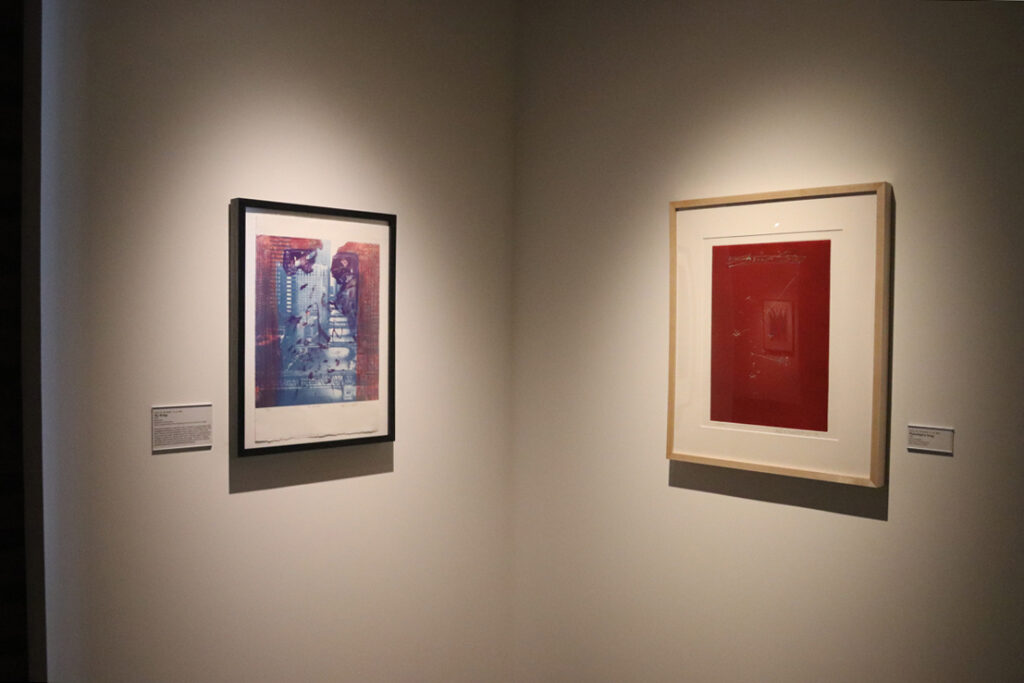
16.
Allan L. Edmunds (b. 1949)
HFA V
2004
Serigraph and collage
Museums Collections, Gift of Experimental Printmaking Institute, Lafayette College
HFA V was produced as part of the “Family Album” series that Allan L. Edmunds began in the 1980s and expanded during his residency at the EPI in 2004. Edmunds layers photographs from his own family archives with his mother’s handwritten notes and the resulting print exemplifies his collaborative and multimedia methods, his narrative style, and his use of varied mark-making techniques.
17.
Allan L. Edmunds (b. 1949)
Irving Fryar
1997
Offset lithograph
Museums Collections, Gift of Brandywine Workshop, Philadelphia, PA
The artist Allan L. Edmunds is the founder and executive director of the Brandywine Workshop, a Philadelphia arts organization established in 1972. Edmunds’ acclaimed work as a printmaker complements his professional efforts to ensure the creation, documentation, and preservation of work by culturally diverse American artists.
Irving Fryar is an example of the offset lithographic techniques he developed through experimentation and collaboration with John E. Dowell Jr., whose work is also on view in this gallery. The print exemplifies Edmunds’ style in its incorporation of photography, computer-generated images, and painterly strokes of color.
18.
John E. Dowell, Jr. (b. 1941)
The Bridge
2004
Serigraph
Museums Collections, Gift of Experimental Printmaking Institute, Lafayette College
Philadelphia-native John E. Dowell Jr. has been a professional photographer, painter, and printmaker for over four decades. Between 1970 and the early 1990s, a driving force in Dowell’s art was his endeavor to interpret jazz music visually. In a 2004 interview, he said, “I became aware that in jazz music, it was not just the notes but the intervals between them that become important.”[3] Philadelphia Song evokes time and music through its sparse articulation of marks in various sizes and colors across the red background of the print.
During his residency at the EPI, Dowell experimented with serigraph techniques to produce prints such as The Bridge, which, like Philadelphia Song, evokes sound. In this case, city sounds are made visible through the layering of a photograph of bridges crossing the Chicago River with a heavily worked frame and painterly marks made directly over the image. The print combines the aerial city views that characterize Dowell’s recent work with his painterly approach to experimental printmaking.
[3] Kim Sajet and Howardena Pindell, The chemistry of color: African-American artists in Philadelphia, 1970-1990 (Philadelphia, PA: Pennsylvania Academy of the Fine Arts, 2005), 54.
19.
John E. Dowell, Jr. (b. 1941)
Philadelphia Song
1981
Color intaglio
Museums Collections, Gift of Paul R. Jones

